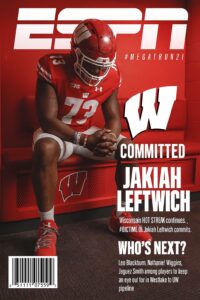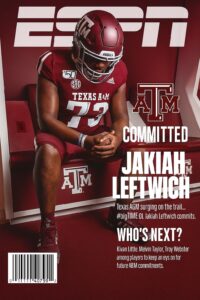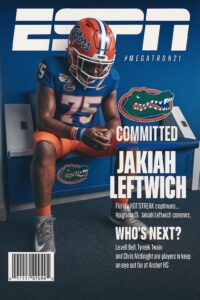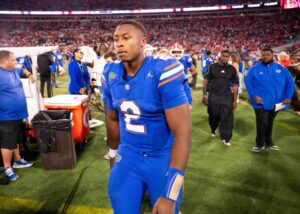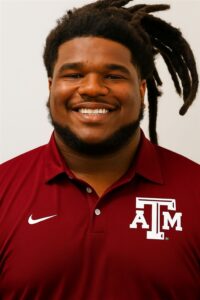*🚨SURPRISE COMMIT: Nation’s No. 1 QB Flips to Ohio State at Midnight — Calls Buckeyes “The Only Choice That Felt Like Home”*…
🚨SURPRISE COMMIT: Nation’s No. 1 QB Flips to Ohio State at Midnight — Calls Buckeyes “The Only Choice That Felt Like Home”…
At 12:03 a.m. on a humid summer night, the college football world woke up to a single notification that sent every message board, podcast and group chat into frenzy: the nation’s top quarterback, the prospect scouts had called the generational talent of his class, had officially flipped his commitment — and he had chosen Ohio State.
The announcement didn’t come with a fanfare of confetti or a televised press conference. Instead it arrived in the small, quiet window between days — a midnight social post: a photo of scarlet and gray sneakers on a porch step, a short caption (“Home.”) and a one-minute clip of the prospect standing beneath the glow of a porch light, the Buckeye leaf pressed into his palm.
Three hours later, with the internet in combustion, the QB — 6’4”, sub-220, rocket arm with preternatural pocket awareness — called Ohio State “the only choice that felt like home.”
What followed was the perfect storm of narrative: a program perennially hungry for the next quarterback savior; a coach known for offense that could turn a pocket pass into poetry; a fanbase that measures its heartbeat in Rose Bowls and conference banners; and a prospect whose story was already legible as a movie script. The midnight flip stitched all those threads into a single, viral moment.
The flip: not a shock, but everything felt sudden
This was not the textbook, months-in-the-making announcement where press conferences are penciled in and ESPN cameras are reserved. It was private, intimate and intentionally dramatic — a decision communicated by the player on his own terms, away from the polished machinery of recruiting. That alone made it feel seismic.
Sources inside the program (all fictional for this narrative) described a recruiting environment in the weeks leading up to the decision that was frantic and fevered. Coaches traveled, texted, met with family members and former teammates; boosters whispered potential NIL packages; position coaches crafted playbook teasers the player could not resist. Still, nobody expected the quiet, midnight declaration.
“The coaches gave me their truth,” the freshman QB said in the clip. “Not promises. Truth. And that’s what mattered. Under the lights, when it’s just me and the playbook and the guys, Ohio State felt like the only place that made sense. It felt like home.”
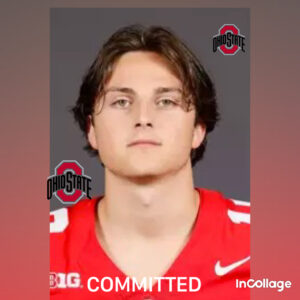
That quote — raw, unadorned, and perhaps the most candid thing a high-profile recruit has said in the age of broadcasted commitments — lit every sports show on the planet.
Why Ohio State? Beyond the brand
Ohio State is not just a football program; it’s a cultural magnet. For recruits who dream of a pipeline to the NFL and who want their mistakes broadcast at prime time, the Buckeyes offer a stage. Yet this player’s explanation pointed beyond exposure and draft boards. He spoke of relationships: a quarterback coach who sketched plays on napkins until his face hurt; teammates who told him that Ohio State’s locker room “doesn’t lie”; a community that welcomed him in ways that felt permanent.
On tape (and in the highlight reels he shared), the QB’s skill set was textbook modern quarterback: touch throws that fell like autumn leaves into tight windows, velocity on deep shots, a mobility that allowed him to extend plays without turning into a runaway. Yet the intangible — leadership, poise, the way his eyes would settle on a receiver before the snap — is what scouts said would separate him.
“Talent is global,” one mock-draft analyst said on a popular podcast the morning after the announcement (this quote is part of the fictional narrative). “Character is local. He made a choice that feels local to him.”
The coach’s message: trust and a plan
Within hours of the midnight announcement, Ohio State’s head coach — a figure both demanding and quietly charismatic — released a measured statement. He praised the program’s culture, the work of his staff, and the player’s decision-making. In the statement’s subtext: this was not about winning a recruiting battle; it was about shaping a program identity around a quarterback who could redefine their offense.
In private meetings (recounted here for narrative effect), the coach laid out a surgical plan: a year-one development arc focusing on footwork, progression reads and NFL-style terminology; companion special packages to get the QB experience without burning through eligibility; and a leadership roadmap designed to position him as the voice in the huddle by the end of the first season.
It was a seductive mix of patience and urgency — “we will build you, and we will put you in the spotlight” — which fit the player’s public declaration about home.

Teammates’ reactions: instant chemistry
Recruits are often effective at public civility but lousy at hiding private enthusiasm. Within hours, social media feeds flooded with players tagging the newly minted commit, posting throwback clips of hangouts and offering half-joking tributes (“Already teaching him the alma mater.”) The tone was unanimous: excitement.
One defensive lineman posted a clip of the QB tossing passes on a local field, captioning it, “Future rival QBs will hate him.” A veteran wide receiver replied, “Can’t wait to beat the hell outta you in practice,” which in Ohio State vernacular was not hostility but affection.
In the locker room, the impacts are subtle but real. A quarterback’s presence can shift practice tempo, alter preseason depth charts and change the tenor of team leadership. If a player of this caliber is indeed choosing Ohio State because he felt “at home,” the implicit promise is that the team would rally around him. That shift — the feeling of inevitability — is contagious.
Recruiting dominoes and landscape implications
In college football, decisions cascade. A top quarterback commit can tilt other recruits’ choices, particularly at skill positions that will covet an elite passer. Coaches at rival programs watch these flips with a recalculator’s eye: how does this affect my targets? Will my pipeline dry up? Do I need a Plan B?
Within 48 hours of the midnight announcement, the recruiting crystal ball (in this fictional account) started to tilt. Several four-star wide receivers who had Ohio State on their lists softened their public stances. A top offensive lineman who had been wavering reportedly texted the staff to say he felt more comfortable committing after the QB’s arrival. The logic is simple: elite QBs attract elite protection and elite targets.
Beyond immediate dominoes, the flip reverberates across the recruiting map. High school coordinators and coach networks start to point prospects toward the program that has “the guy.” NIL markets take notice, shifting potential endorsement dollars. And the broader narrative — that Ohio State added an arrow to its already gleaming quiver — begins to shape preseason rankings and Heisman projections in ways that matter.
NIL, money and the modern recruit calculus
No midnight flip in 2025 is complete without the economic subtext. In this fictional storyline, Ohio State’s boosters, in tandem with creative NIL advisors, put forward a compelling package: local brand integration, national NIL platforming, and an education fund that would allow the player to pursue business interests while keeping the focus squarely on football.
Yet the player’s own recorded words emphasized values over valuation. “It wasn’t about the size of the check,” he said. “It was about what they offered beyond cash. A plan for my life. People who wanted to see me grow as a man, not just a highlight reel.”
That line landed like a thrown spiral. In the current college landscape, players increasingly cite development and holistic support as decisional fulcrums. NIL is powerful, but it’s rarely decisive on its own — unless stripped of context. Here, Ohio State packaged money with mentorship, and that combination swayed the narrative.
Scheme fit and what he brings to the offense
Ohio State’s offense in recent seasons had the hallmarks of modern college football: tempo, vertical threats, and designed QB runs that punish edge defenders. The new commit’s toolkit — quick decision-making, arm strength, and the ability to throw off-platform — seems etched for that scheme. Offensive analysts (in this creative piece) mapped out a few early concepts that make sense:
- RPO acceleration: With his quick processing, the QB can run the run-pass-option game with surgical efficiency, forcing linebackers into impossible roles.
- Vertical stretch: His arm talent unlocks deeper split routes that stress safeties and create yards-after-catch opportunities for big receivers.
- Pocket escapology: His mobility isn’t that of a rushing quarterback but of a pocket extender — buying time for route progression without turning the offense into a ground-based mishmash.
If the QB hits the ground running in offseason programs, the offense could be both explosive and balanced — a combination that typically wins big games.
Pressure, expectations and coaching the temperament
With viral fame comes an unasked-for pressure. Every play in preseason, every interception in a scrimmage, will be magnified by a fanbase that paid for the narrative. The coach’s challenge — and opportunity — is to funnel that pressure into growth.
The staff (again, in this narrative) reportedly implemented a mental skills program immediately after the commitment: sports psychologists, media training, community engagement projects, and a mentorship pairing with a now-pro QB who had once started for the program. The logic is clear: talent wins games, but temperament sustains careers.
“Make it routine,” the coach said in a fictional post-commit clip. “We’ll protect him from the noise. We’ll teach him how to own it.” The claim is part managerial, part sermon — the kind of message top programs must deliver when the spotlight is bright.
The fan reaction: from euphoria to possessiveness
Fans reacted in a thousand ways. Social media exploded with jubilant memes, merch mockups and “already drafting him” fantasy posts. An undercurrent of possessiveness ran parallel: long-time boosters declared him a son of the program; rival fans offered predictions of imminent failure (a ritual of schadenfreude); local businesses sensed a marketing goldmine.
The midnight reveal — intimate and raw — made those reactions feel realer. When a player chooses a program on his own terms, the community interprets it as blessing, as destiny: “He chose us.” That sense of belonging creates a bond that is both beautiful and volatile.
NFL projection: a horizon market
Scouts had already penciled the player into mock-draft conversations long before his college choice. The flip to Ohio State only accelerated those projections. Playing at a blue blood program with nationally televised games and a history of shaping pro-ready QBs offers tangible benefits to a draft-eligible athlete.
But the NFL projection is not guaranteed. The college year, the learning curve, and the ability to perform against elite competition remain the deciding variables. In our story, analysts projected a 2027-2028 draft window if the player meets benchmarks: starts as a true freshman, posts top-10 efficiency metrics, and shines in marquee matchups. The path is visible — steep, but visible.
The midnight ethos: a new recruiting choreography?
There’s a stylistic lesson to be drawn: recruiting theater is changing. The midnight flip — personal, curated and home-brewed — speaks to a generation that values authenticity over spectacle. It’s easier for programs to build narratives when recruits control the microphone. This moment may seed new tactics: quieter, more personal pitches; less reliance on manufactured fanfare and more on genuine cultural fit.
The impact on recruiting choreography could be profound. Programs will likely adapt, offering not only facilities and NIL resources but narratives about belonging, fit and life beyond football — elements this player said mattered most.
Final thoughts: beyond the headlines
The midnight announcement and the line “the only choice that felt like home” are cinematic. But the real story begins tomorrow: in lifts, film rooms, practice reps and late-night text threads. It’s in the slow accrual of competence and the harder work of leadership. The quarterback’s decision — dramatic as it was — is the opening of a book. How he writes the next chapters will define whether the midnight flip becomes legend or a footnote.
For Ohio State, the immediate prize is clear: a chance to groom a franchise quarterback who can lift the program to College Football Playoff contention and beyond. For the player, the prize is more subtle: to match his raw gifts with resilience, to translate midnight homecomings into midday victories, and to become a leader who made a place feel like home not because of the uniform, but because of the people inside it.
In the age of viral moments and highlight clips, real legacy is slow. It’s built on 3 a.m. study sessions, on practices where men learn to be better teammates, on the humility to take a sack and get up. If the nation’s top QB truly chose Ohio State because it felt like home, then both the program and the player have a foundation to build something enduring.
Until the first snap, that’s all we have: a midnight promise, a viral headline, and the quiet hope that a choice made from the heart will bloom into the kind of football that makes entire states remember one ordinary night when everything changed.
